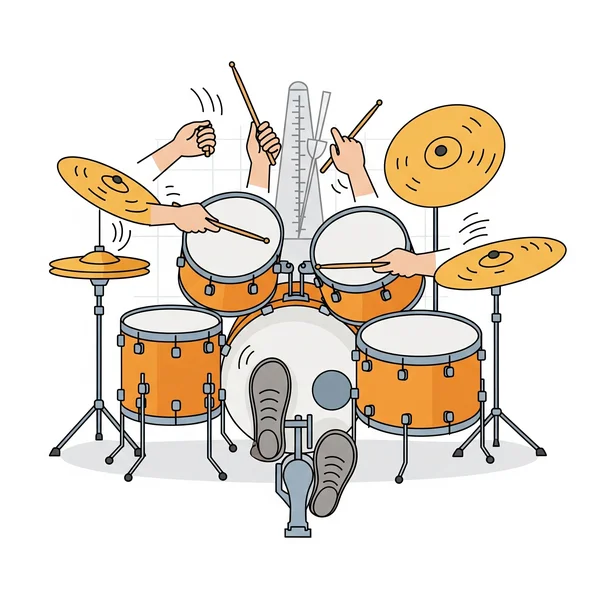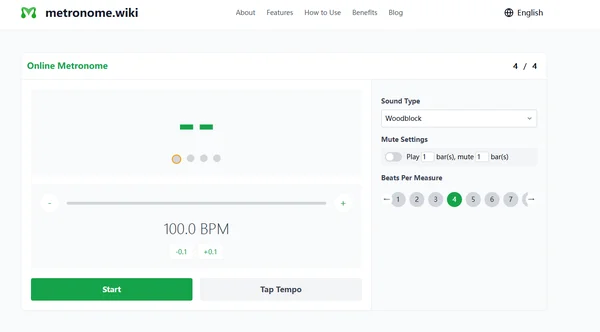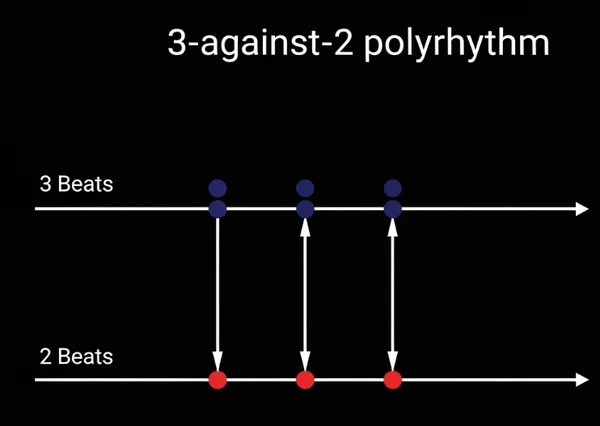Master Polyrhythms: Drummer's Guide with Online Metronome
For drummers and adventurous musicians, mastering polyrhythms can feel like unlocking a new level of rhythmic expression. But how to practice polyrhythms with a metronome effectively, especially those tricky 3 against 2 or 4 against 3 patterns? This guide is your secret weapon, showing you how polyrhythms metronome practice, powered by a versatile online metronome with clear metronome subdivisions, can demystify these complex rhythms. Get ready to elevate your rhythm for drummers and overall musicality with our free online tool.
I. Introduction: Embracing the Challenge of Polyrhythms for Drummers (and Beyond)
Polyrhythms – the simultaneous use of two or more independent rhythms – are a hallmark of advanced drumming and sophisticated musicianship across various genres. While they might seem daunting at first, understanding and executing them adds incredible depth and texture to your playing. This article will guide you, focusing primarily on drumming exercises, but the principles apply to any musician looking to expand their rhythmic vocabulary. The key is consistent metronome practice with the right approach and a helpful online metronome.

II. What Are Polyrhythms? Demystifying These Complex Rhythms
What are polyrhythms in drumming and music in general? Let's break down this fascinating rhythmic concept.
Defining Polyrhythms: More Than Just "Different Rhythms Together"
A polyrhythm isn't just playing two different rhythms sequentially; it's the art of layering them so they occur at the same time, creating a rich, interwoven rhythmic fabric. This requires significant rhythmic independence between limbs or musical lines. True understanding polyrhythms involves feeling how these distinct pulses interact.
Common Polyrhythms Explained: 3 against 2 (3:2) and 4 against 3 (4:3)
Two of the most foundational polyrhythms you'll encounter are:
-
3 against 2 (3:2): This means one part plays three evenly spaced notes in the same amount of time that another part plays two evenly spaced notes. Think of the phrase "Hot cup of tea" (3) against "Coffee" (2).
-
4 against 3 (4:3): Here, one part plays four notes while another plays three in the same duration. A common mnemonic is "Pass the god-damn butter." Visualizing these with
metronome clicksproperly subdivided is crucial.

Why Mastering Polyrhythms Elevates Your Drumming Exercises and Musicality
Incorporating polyrhythms metronome practice into your routine dramatically improves your:
- Limb Independence: Essential for drummers.
- Internal Clock: You'll develop a more nuanced sense of time.
- Groove Enhancement: Polyrhythms add a unique flavor to your beats and fills.
- Rhythmic Vocabulary: You expand your creative possibilities.
These are not just
complex rhythms; they are tools for deeper musical expression.
III. Your Essential Tool: Setting Up the Online Metronome for Polyrhythm Practice
How to understand complex rhythms on metronome? The right setup with your online metronome is paramount. A free metronome like the one at metronome.wiki offers the flexibility needed.
The Power of Metronome Subdivisions for Polyrhythms
This is where an online metronome with robust metronome subdivisions truly shines. To practice a polyrhythm, you need to find the smallest common rhythmic unit that both parts of the polyrhythm share. For example, in a 3:2 polyrhythm, if the "2" side represents quarter notes, the "3" side can be thought of as quarter-note triplets. An online metronome that can clearly articulate these beat subdivision patterns (e.g., by clicking eighth-note triplets or sixteenth notes) is invaluable. You can explore these subdivision options on our tool.
Finding the Common Pulse: Key to Polyrhythm Metronome Settings
The core of setting up your polyrhythms metronome practice is to identify the underlying pulse where both rhythmic layers align. For 3:2, this often means feeling the pulse in groups of six (the least common multiple of 2 and 3). For 4:3, it's groups of twelve. Your online metronome should be set to a tempo that allows these subdivisions to be clear and manageable.
Visualizing and Hearing Polyrhythms with Your Metronome Online
Before you even play, set up the metronome subdivisions on our online metronome to represent both parts of the polyrhythm (e.g., one hand taps the main beat, another taps the triplet over it). Listen carefully. Try to clap or vocalize each part separately against the combined click, then attempt both.

IV. Step-by-Step Drumming Exercises: Practicing Polyrhythms with Your Metronome
What are good drumming exercises for polyrhythms? Let's get practical with some drumming exercises using your online metronome.
Tackling 3:2 Polyrhythms: Exercises Using Your Online Metronome
This is often the first polyrhythm musicians learn.
- Setting up subdivisions: On our metronome tool, set a comfortable
tempo. If you're thinking of the "2" side as quarter notes, you can set themetronome subdivisionsto eighth-note triplets. The "2" side will align with every third triplet click, and the "3" side with every second triplet click. - Limb independence exercises:
- Right hand plays 2 (on main beat/every third triplet), left hand plays 3 (on every second triplet).
- Switch hands.
- Right foot plays 2, right hand plays 3. Explore all limb combinations.
These
three against two exercisesbuild essential coordination.
Conquering 4:3 Polyrhythms: Drills with Clear Metronome Subdivisions
This is a step up in complexity.
- Finding the 12-beat cycle: The smallest rhythmic unit where 4 and 3 align is 12 (e.g., if "3" is quarter notes, "4" can be dotted eighth notes, or you can think in 16th note triplets). Use the
online metronome subdivisionson metronome.wiki to make this 12-unit pulse clear. - Gradual tempo increase: Start these
advanced metronome exercisesvery slowly. Once a pattern is stable, gradually increase thetempoon youronline metronome. Focus onlimb independence exercisessimilar to the 3:2, but with the 4:3 ratio.
Tips for Smooth Polyrhythm Execution: Counting, Feeling, and Listening
-
Counting: Use specific phrases (like "Hot cup of tea" or "Pass the god-damn butter") or numerical counting systems.
-
Feeling: Try to internalize the overall
rhythmic pulseandfeel the polyrhythmrather than just mathematically calculating it. -
Active Listening: Listen to music rich in polyrhythms to develop your ear.

V. Polyrhythms for All Musicians: Adapting Exercises Beyond Drumming
While often associated with rhythm for drummers, polyrhythms are for everyone! Can I use an online metronome for 3 against 2 if I'm not a drummer? Yes!
Guitarists and Pianists: Applying Polyrhythm Concepts
Guitarists can practice fingerpicking patterns or strumming rhythms that embody polyrhythms. Pianists have a natural advantage with two hands for rhythmic independence. Use metronome subdivisions on your online metronome to guide comping patterns or melodic lines.
Vocalists and Wind Players: Internalizing Complex Rhythms
Vocalists can sing melodic phrases that imply one side of a polyrhythm against an accompaniment playing the other. Wind players can work on rhythmic phrasing and articulation. The metronome practice is about internalizing these complex rhythms.
Using Your Online Metronome's Versatility for Any Instrument
The beauty of a flexible online metronome, like the free metronome at metronome.wiki, is its adaptability. You can adjust tempo, time signatures, and crucially, metronome subdivisions to suit any instrument and any polyrhythmic challenge.
VI. Elevate Your Rhythm for Drummers (and All Musicians) with Polyrhythm Mastery
Mastering polyrhythms is a journey that significantly enhances your rhythmic capabilities, especially crucial for rhythm for drummers but beneficial for all musicians. It opens up new avenues for expression and deepens your understanding of complex rhythms. With dedicated polyrhythms metronome practice and a reliable tool like our free online metronome that offers clear metronome subdivisions, you can conquer these fascinating rhythmic challenges.
Ready to take your drumming exercises and rhythmic understanding to the next level? Start exploring polyrhythms today with our versatile online tool! What are your favorite polyrhythms to practice? Share your tips or challenges in the comments below!
VII. Your Polyrhythm Metronome Practice Questions Answered
-
How do metronome subdivisions help with polyrhythms?
Metronome subdivisionsare key because they allow you to hear and feel the smallest common rhythmic unit between the different parts of a polyrhythm. For example, to practice3 against 2, setting youronline metronometo click eighth-note triplets makes it easier to place both the "2" and "3" accurately. Try our subdivision options. -
Can I use an online metronome for 3 against 2?
Absolutely! Set your
online metronometo a base pulse, then usemetronome subdivisions(like triplets if the "2" is the main beat) or count carefully to layer the "3" part over the "2" part. Many find afree metronomelike ours perfectly suited for this. -
What are good drumming exercises for polyrhythms?
Start with basic
limb independence exercisesfor 3:2 and 4:3, assigning each rhythm to different limbs. Gradually incorporate them into simple beats and fills. Using anonline metronomewith clearmetronome clicksfor each subdivision is vital. -
Are there free metronomes good for polyrhythm practice?
Yes, a
free metronomelike the one at metronome.wiki that offers flexibletempocontrol and, crucially, variousonline metronome subdivisions(like triplets, sixteenths) is excellent for practicing polyrhythms without any cost. -
How to understand complex rhythms on metronome?
Start by breaking the
complex rhythmsdown. Identify the underlying pulse and the relationship between the different rhythmic layers. Use youronline metronomewith appropriatemetronome subdivisionsto hear how they fit together. Slow, focusedmetronome practiceis essential.